Commercial Project Negotiation: Queensland Health & Channel Tunnel
VerifiedAdded on 2023/06/03
|11
|2344
|109
Report
AI Summary
This report provides a detailed analysis of commercial project negotiation, using the Queensland Health payroll system and the Channel Tunnel project as case studies. It explores various aspects of project negotiation, including stakeholder engagement, conflict management, and different negotiation methods. The report examines the factors influencing stakeholder agendas, the methods used in project negotiations, and strategies for conflict management. It also delves into the importance of stakeholder engagement for successful project delivery. The study offers conclusions and recommendations for improving project negotiation practices. The report highlights the challenges faced by contractors and stakeholders in negotiating major projects and emphasizes the need for structured approaches to commercial negotiation. References to relevant literature are included to support the analysis and findings.
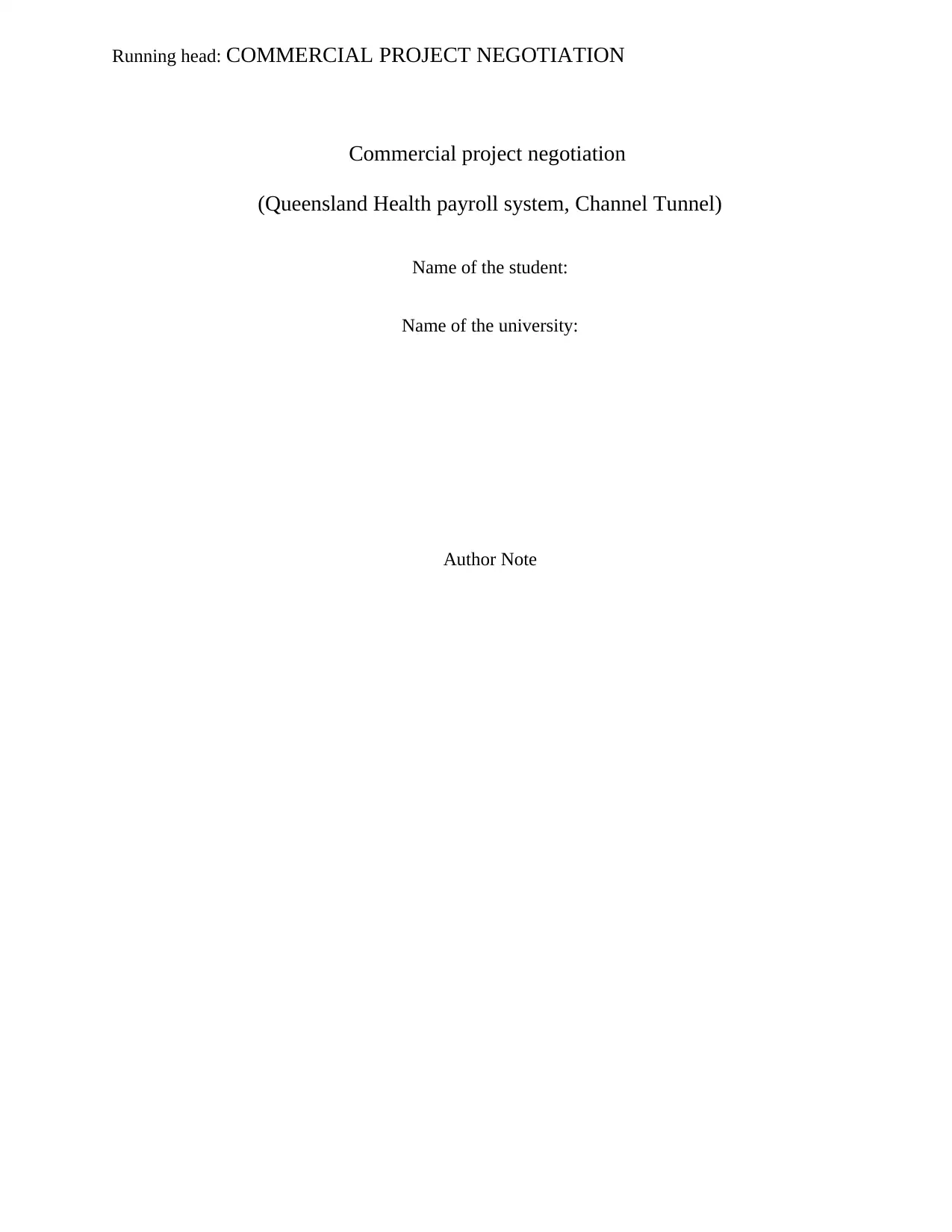
Running head: COMMERCIAL PROJECT NEGOTIATION
Commercial project negotiation
(Queensland Health payroll system, Channel Tunnel)
Name of the student:
Name of the university:
Author Note
Commercial project negotiation
(Queensland Health payroll system, Channel Tunnel)
Name of the student:
Name of the university:
Author Note
Paraphrase This Document
Need a fresh take? Get an instant paraphrase of this document with our AI Paraphraser
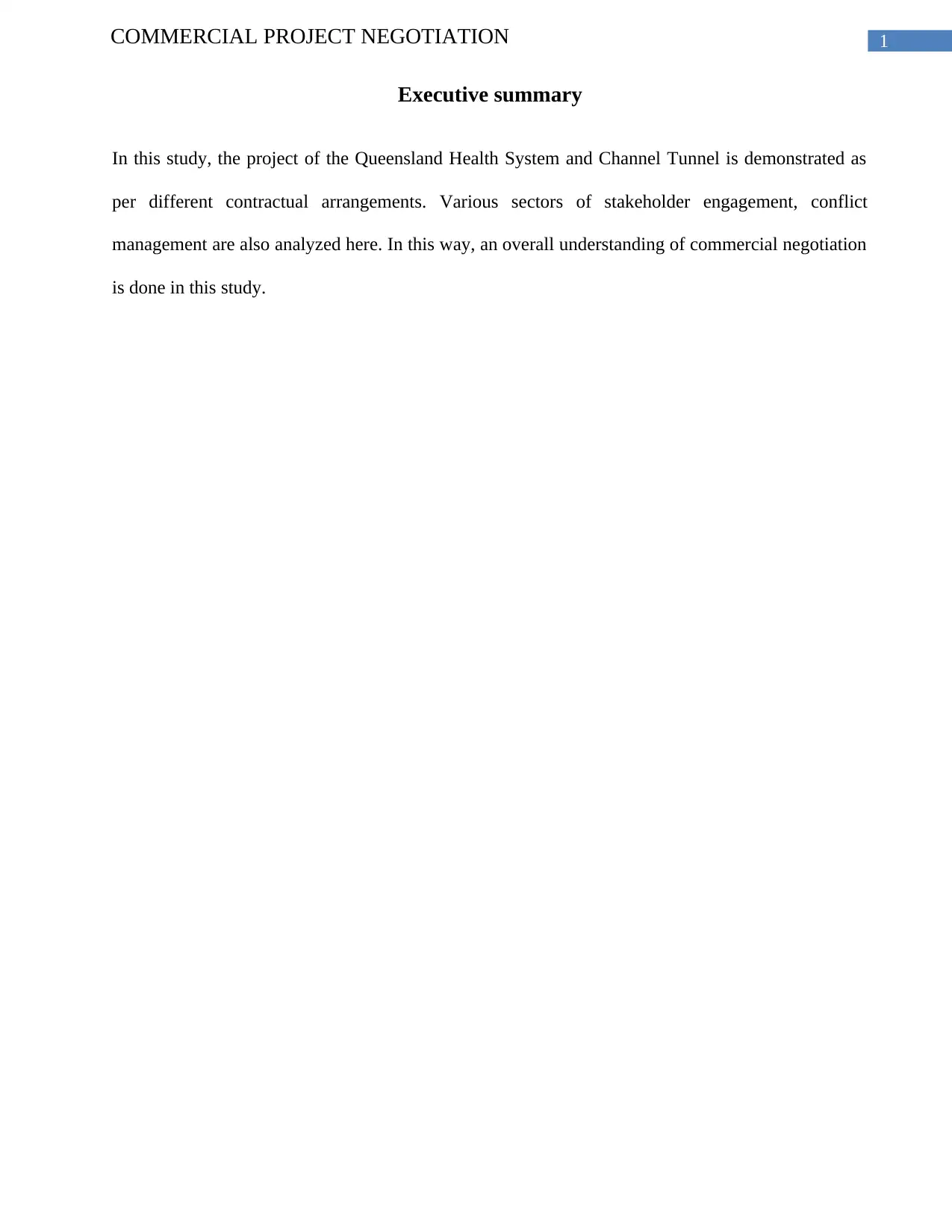
1COMMERCIAL PROJECT NEGOTIATION
Executive summary
In this study, the project of the Queensland Health System and Channel Tunnel is demonstrated as
per different contractual arrangements. Various sectors of stakeholder engagement, conflict
management are also analyzed here. In this way, an overall understanding of commercial negotiation
is done in this study.
Executive summary
In this study, the project of the Queensland Health System and Channel Tunnel is demonstrated as
per different contractual arrangements. Various sectors of stakeholder engagement, conflict
management are also analyzed here. In this way, an overall understanding of commercial negotiation
is done in this study.

2COMMERCIAL PROJECT NEGOTIATION
Table of Contents
1. Introduction:......................................................................................................................................3
2. Description and discussion of the projects:.......................................................................................3
2.1. Health payroll system in Queensland:........................................................................................3
2.2. Channel tunnel project:...............................................................................................................4
3. Factors of stakeholder agenda:..........................................................................................................4
4. Methods of project negotiations:.......................................................................................................5
5. Conflict management:........................................................................................................................6
6. Stakeholder engagement:...................................................................................................................6
7. Conclusions:......................................................................................................................................7
8. Recommendations:............................................................................................................................7
9. References:........................................................................................................................................8
Table of Contents
1. Introduction:......................................................................................................................................3
2. Description and discussion of the projects:.......................................................................................3
2.1. Health payroll system in Queensland:........................................................................................3
2.2. Channel tunnel project:...............................................................................................................4
3. Factors of stakeholder agenda:..........................................................................................................4
4. Methods of project negotiations:.......................................................................................................5
5. Conflict management:........................................................................................................................6
6. Stakeholder engagement:...................................................................................................................6
7. Conclusions:......................................................................................................................................7
8. Recommendations:............................................................................................................................7
9. References:........................................................................................................................................8
⊘ This is a preview!⊘
Do you want full access?
Subscribe today to unlock all pages.

Trusted by 1+ million students worldwide
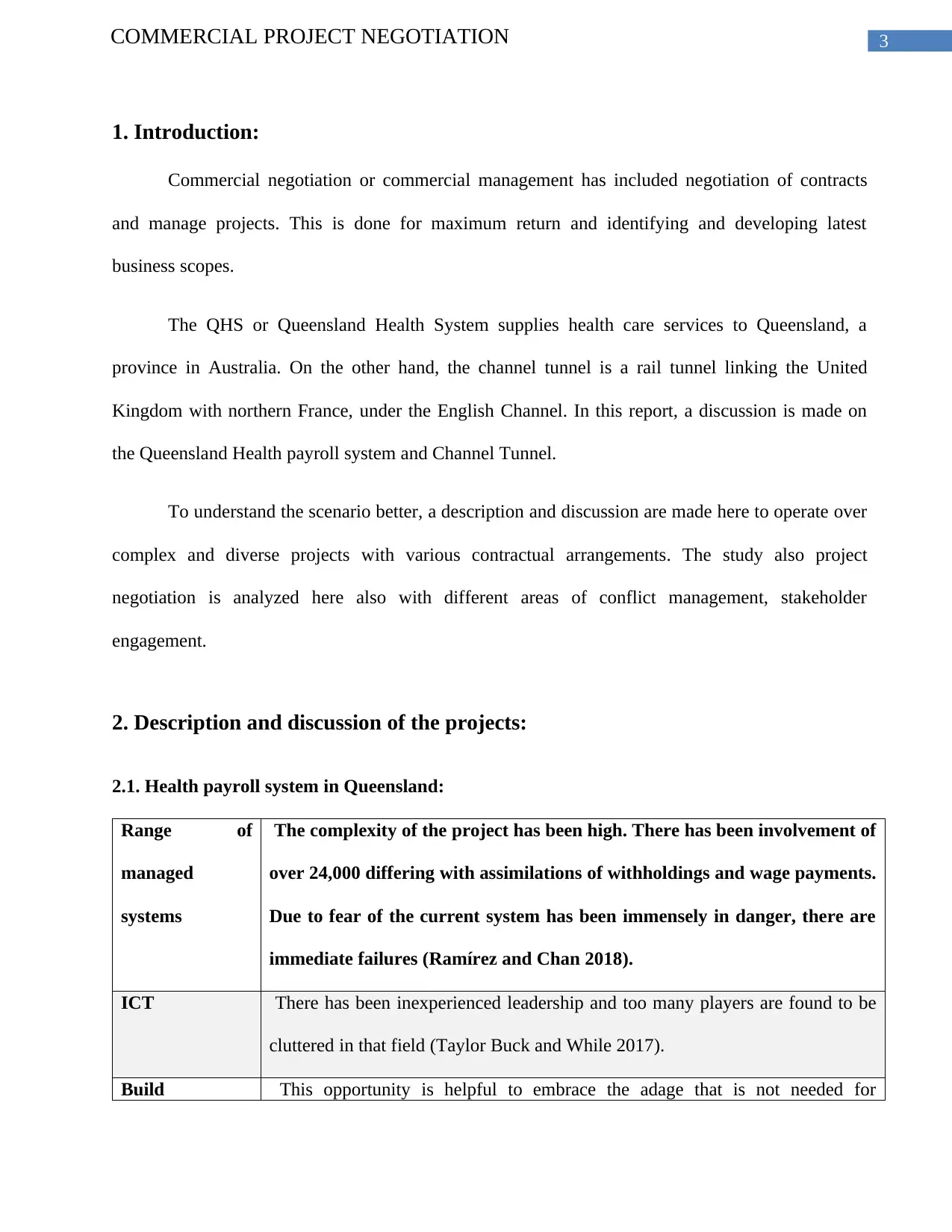
3COMMERCIAL PROJECT NEGOTIATION
1. Introduction:
Commercial negotiation or commercial management has included negotiation of contracts
and manage projects. This is done for maximum return and identifying and developing latest
business scopes.
The QHS or Queensland Health System supplies health care services to Queensland, a
province in Australia. On the other hand, the channel tunnel is a rail tunnel linking the United
Kingdom with northern France, under the English Channel. In this report, a discussion is made on
the Queensland Health payroll system and Channel Tunnel.
To understand the scenario better, a description and discussion are made here to operate over
complex and diverse projects with various contractual arrangements. The study also project
negotiation is analyzed here also with different areas of conflict management, stakeholder
engagement.
2. Description and discussion of the projects:
2.1. Health payroll system in Queensland:
Range of
managed
systems
The complexity of the project has been high. There has been involvement of
over 24,000 differing with assimilations of withholdings and wage payments.
Due to fear of the current system has been immensely in danger, there are
immediate failures (Ramírez and Chan 2018).
ICT There has been inexperienced leadership and too many players are found to be
cluttered in that field (Taylor Buck and While 2017).
Build This opportunity is helpful to embrace the adage that is not needed for
1. Introduction:
Commercial negotiation or commercial management has included negotiation of contracts
and manage projects. This is done for maximum return and identifying and developing latest
business scopes.
The QHS or Queensland Health System supplies health care services to Queensland, a
province in Australia. On the other hand, the channel tunnel is a rail tunnel linking the United
Kingdom with northern France, under the English Channel. In this report, a discussion is made on
the Queensland Health payroll system and Channel Tunnel.
To understand the scenario better, a description and discussion are made here to operate over
complex and diverse projects with various contractual arrangements. The study also project
negotiation is analyzed here also with different areas of conflict management, stakeholder
engagement.
2. Description and discussion of the projects:
2.1. Health payroll system in Queensland:
Range of
managed
systems
The complexity of the project has been high. There has been involvement of
over 24,000 differing with assimilations of withholdings and wage payments.
Due to fear of the current system has been immensely in danger, there are
immediate failures (Ramírez and Chan 2018).
ICT There has been inexperienced leadership and too many players are found to be
cluttered in that field (Taylor Buck and While 2017).
Build This opportunity is helpful to embrace the adage that is not needed for
Paraphrase This Document
Need a fresh take? Get an instant paraphrase of this document with our AI Paraphraser
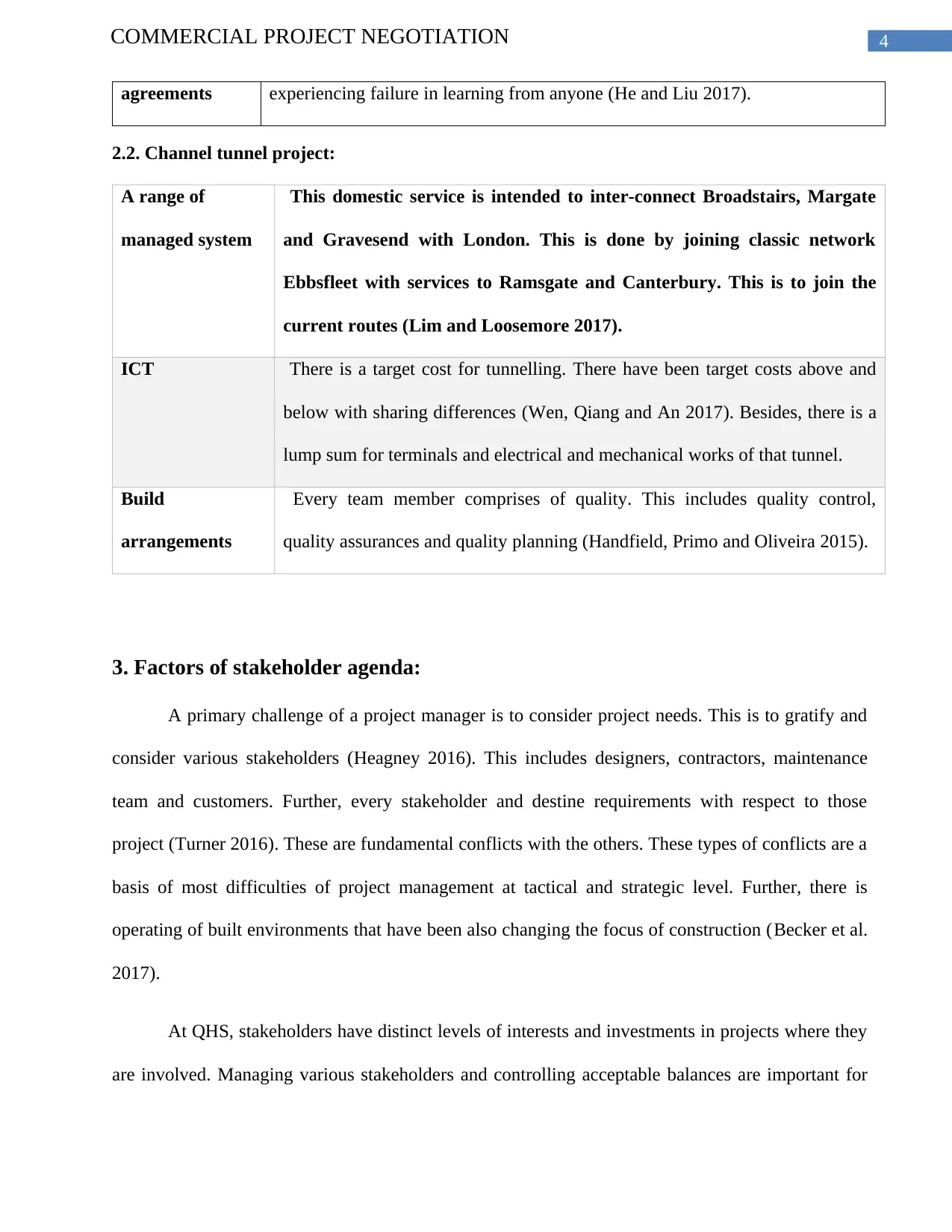
4COMMERCIAL PROJECT NEGOTIATION
agreements experiencing failure in learning from anyone (He and Liu 2017).
2.2. Channel tunnel project:
A range of
managed system
This domestic service is intended to inter-connect Broadstairs, Margate
and Gravesend with London. This is done by joining classic network
Ebbsfleet with services to Ramsgate and Canterbury. This is to join the
current routes (Lim and Loosemore 2017).
ICT There is a target cost for tunnelling. There have been target costs above and
below with sharing differences (Wen, Qiang and An 2017). Besides, there is a
lump sum for terminals and electrical and mechanical works of that tunnel.
Build
arrangements
Every team member comprises of quality. This includes quality control,
quality assurances and quality planning (Handfield, Primo and Oliveira 2015).
3. Factors of stakeholder agenda:
A primary challenge of a project manager is to consider project needs. This is to gratify and
consider various stakeholders (Heagney 2016). This includes designers, contractors, maintenance
team and customers. Further, every stakeholder and destine requirements with respect to those
project (Turner 2016). These are fundamental conflicts with the others. These types of conflicts are a
basis of most difficulties of project management at tactical and strategic level. Further, there is
operating of built environments that have been also changing the focus of construction (Becker et al.
2017).
At QHS, stakeholders have distinct levels of interests and investments in projects where they
are involved. Managing various stakeholders and controlling acceptable balances are important for
agreements experiencing failure in learning from anyone (He and Liu 2017).
2.2. Channel tunnel project:
A range of
managed system
This domestic service is intended to inter-connect Broadstairs, Margate
and Gravesend with London. This is done by joining classic network
Ebbsfleet with services to Ramsgate and Canterbury. This is to join the
current routes (Lim and Loosemore 2017).
ICT There is a target cost for tunnelling. There have been target costs above and
below with sharing differences (Wen, Qiang and An 2017). Besides, there is a
lump sum for terminals and electrical and mechanical works of that tunnel.
Build
arrangements
Every team member comprises of quality. This includes quality control,
quality assurances and quality planning (Handfield, Primo and Oliveira 2015).
3. Factors of stakeholder agenda:
A primary challenge of a project manager is to consider project needs. This is to gratify and
consider various stakeholders (Heagney 2016). This includes designers, contractors, maintenance
team and customers. Further, every stakeholder and destine requirements with respect to those
project (Turner 2016). These are fundamental conflicts with the others. These types of conflicts are a
basis of most difficulties of project management at tactical and strategic level. Further, there is
operating of built environments that have been also changing the focus of construction (Becker et al.
2017).
At QHS, stakeholders have distinct levels of interests and investments in projects where they
are involved. Managing various stakeholders and controlling acceptable balances are important for
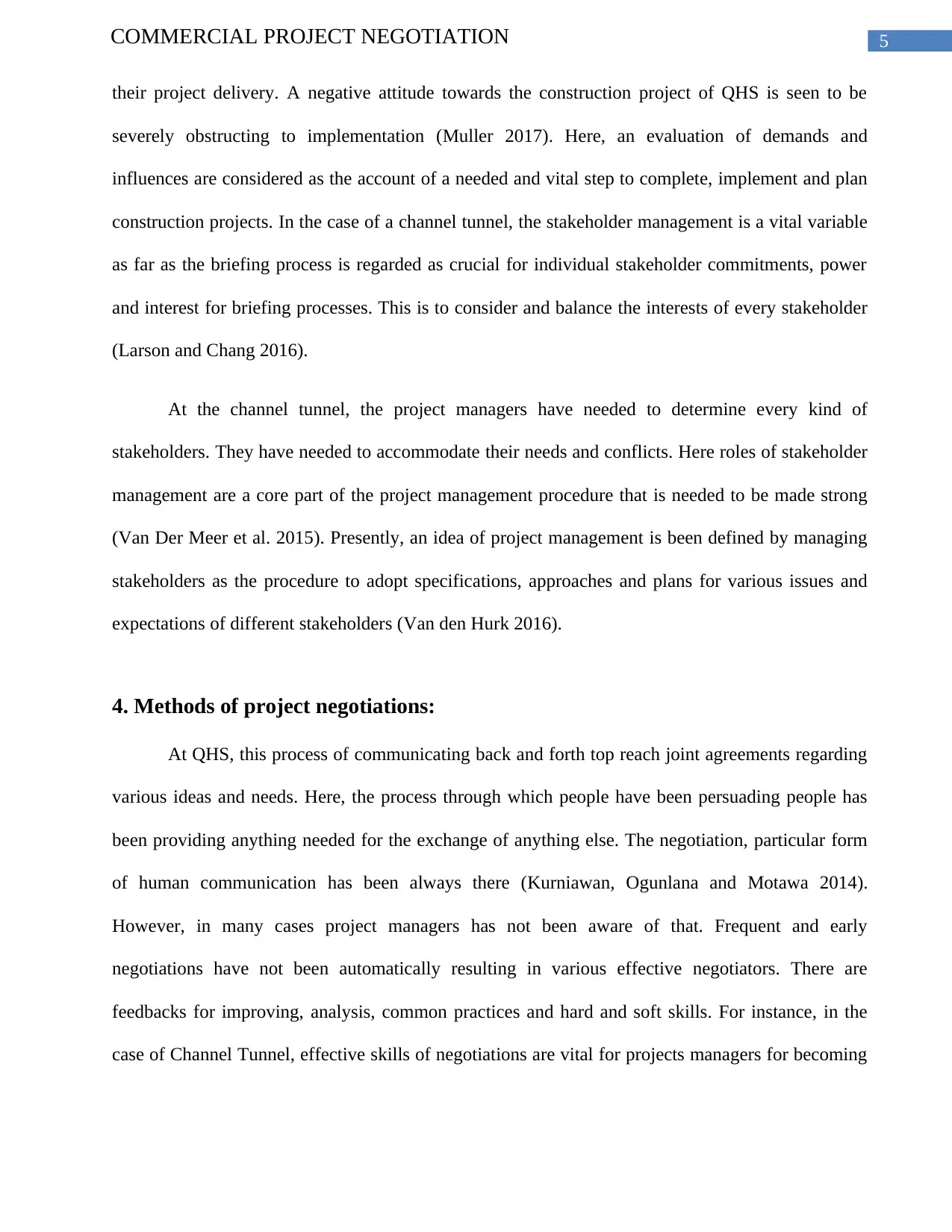
5COMMERCIAL PROJECT NEGOTIATION
their project delivery. A negative attitude towards the construction project of QHS is seen to be
severely obstructing to implementation (Muller 2017). Here, an evaluation of demands and
influences are considered as the account of a needed and vital step to complete, implement and plan
construction projects. In the case of a channel tunnel, the stakeholder management is a vital variable
as far as the briefing process is regarded as crucial for individual stakeholder commitments, power
and interest for briefing processes. This is to consider and balance the interests of every stakeholder
(Larson and Chang 2016).
At the channel tunnel, the project managers have needed to determine every kind of
stakeholders. They have needed to accommodate their needs and conflicts. Here roles of stakeholder
management are a core part of the project management procedure that is needed to be made strong
(Van Der Meer et al. 2015). Presently, an idea of project management is been defined by managing
stakeholders as the procedure to adopt specifications, approaches and plans for various issues and
expectations of different stakeholders (Van den Hurk 2016).
4. Methods of project negotiations:
At QHS, this process of communicating back and forth top reach joint agreements regarding
various ideas and needs. Here, the process through which people have been persuading people has
been providing anything needed for the exchange of anything else. The negotiation, particular form
of human communication has been always there (Kurniawan, Ogunlana and Motawa 2014).
However, in many cases project managers has not been aware of that. Frequent and early
negotiations have not been automatically resulting in various effective negotiators. There are
feedbacks for improving, analysis, common practices and hard and soft skills. For instance, in the
case of Channel Tunnel, effective skills of negotiations are vital for projects managers for becoming
their project delivery. A negative attitude towards the construction project of QHS is seen to be
severely obstructing to implementation (Muller 2017). Here, an evaluation of demands and
influences are considered as the account of a needed and vital step to complete, implement and plan
construction projects. In the case of a channel tunnel, the stakeholder management is a vital variable
as far as the briefing process is regarded as crucial for individual stakeholder commitments, power
and interest for briefing processes. This is to consider and balance the interests of every stakeholder
(Larson and Chang 2016).
At the channel tunnel, the project managers have needed to determine every kind of
stakeholders. They have needed to accommodate their needs and conflicts. Here roles of stakeholder
management are a core part of the project management procedure that is needed to be made strong
(Van Der Meer et al. 2015). Presently, an idea of project management is been defined by managing
stakeholders as the procedure to adopt specifications, approaches and plans for various issues and
expectations of different stakeholders (Van den Hurk 2016).
4. Methods of project negotiations:
At QHS, this process of communicating back and forth top reach joint agreements regarding
various ideas and needs. Here, the process through which people have been persuading people has
been providing anything needed for the exchange of anything else. The negotiation, particular form
of human communication has been always there (Kurniawan, Ogunlana and Motawa 2014).
However, in many cases project managers has not been aware of that. Frequent and early
negotiations have not been automatically resulting in various effective negotiators. There are
feedbacks for improving, analysis, common practices and hard and soft skills. For instance, in the
case of Channel Tunnel, effective skills of negotiations are vital for projects managers for becoming
⊘ This is a preview!⊘
Do you want full access?
Subscribe today to unlock all pages.

Trusted by 1+ million students worldwide

6COMMERCIAL PROJECT NEGOTIATION
successful (Benzer et al. 2015). Processes of effectively opportunistic interactions between two or
more parties are present with apparent conflicts.
5. Conflict management:
Conflict is inevitable in project management. In QHS, a potential for conflict in information
system development projects has been huge. This is because it has involved people from various
backgrounds and orientations. They have been working together on completing complicated
activities (Liu, Yu and Cheah 2014). Here the cause of conflicts under team projects is related to
various values, personalities, resources perceptions, expectations, needs, attitudes and so on. There
are proper skills that have been dealt with conflicts where project managers can assist various
organization members (Peña-mora and Tamaki 2001-3). This is to handle and resolve conflicts. This
has been leading to more project as a whole. At channel tunnel, project management has been
depending on repeatable and proven techniques and processes (Hart and Bubb 2016). Here,
techniques and processes are used for coordinating resources for accomplishing various predictable
results. Though success can never be guaranteed, the project of channel tunnel has been more likely
successful as the traditional processes of project management are deployed (Oraee et al. 2017).
6. Stakeholder engagement:
This is the arguably the most vital ingredient for successful project delivery. This it is seen as
the fringe activity and can be outsourced easily to functions that are business-as-usual for QHS
(Winch and Leiringer 2016). At channel tunnel, the project managers have been depending on
people for responding to benefits and outputs that are to be delivered. Here, stakeholders have been
responding as they are engaged (Brady and Davies 2014).
successful (Benzer et al. 2015). Processes of effectively opportunistic interactions between two or
more parties are present with apparent conflicts.
5. Conflict management:
Conflict is inevitable in project management. In QHS, a potential for conflict in information
system development projects has been huge. This is because it has involved people from various
backgrounds and orientations. They have been working together on completing complicated
activities (Liu, Yu and Cheah 2014). Here the cause of conflicts under team projects is related to
various values, personalities, resources perceptions, expectations, needs, attitudes and so on. There
are proper skills that have been dealt with conflicts where project managers can assist various
organization members (Peña-mora and Tamaki 2001-3). This is to handle and resolve conflicts. This
has been leading to more project as a whole. At channel tunnel, project management has been
depending on repeatable and proven techniques and processes (Hart and Bubb 2016). Here,
techniques and processes are used for coordinating resources for accomplishing various predictable
results. Though success can never be guaranteed, the project of channel tunnel has been more likely
successful as the traditional processes of project management are deployed (Oraee et al. 2017).
6. Stakeholder engagement:
This is the arguably the most vital ingredient for successful project delivery. This it is seen as
the fringe activity and can be outsourced easily to functions that are business-as-usual for QHS
(Winch and Leiringer 2016). At channel tunnel, the project managers have been depending on
people for responding to benefits and outputs that are to be delivered. Here, stakeholders have been
responding as they are engaged (Brady and Davies 2014).
Paraphrase This Document
Need a fresh take? Get an instant paraphrase of this document with our AI Paraphraser
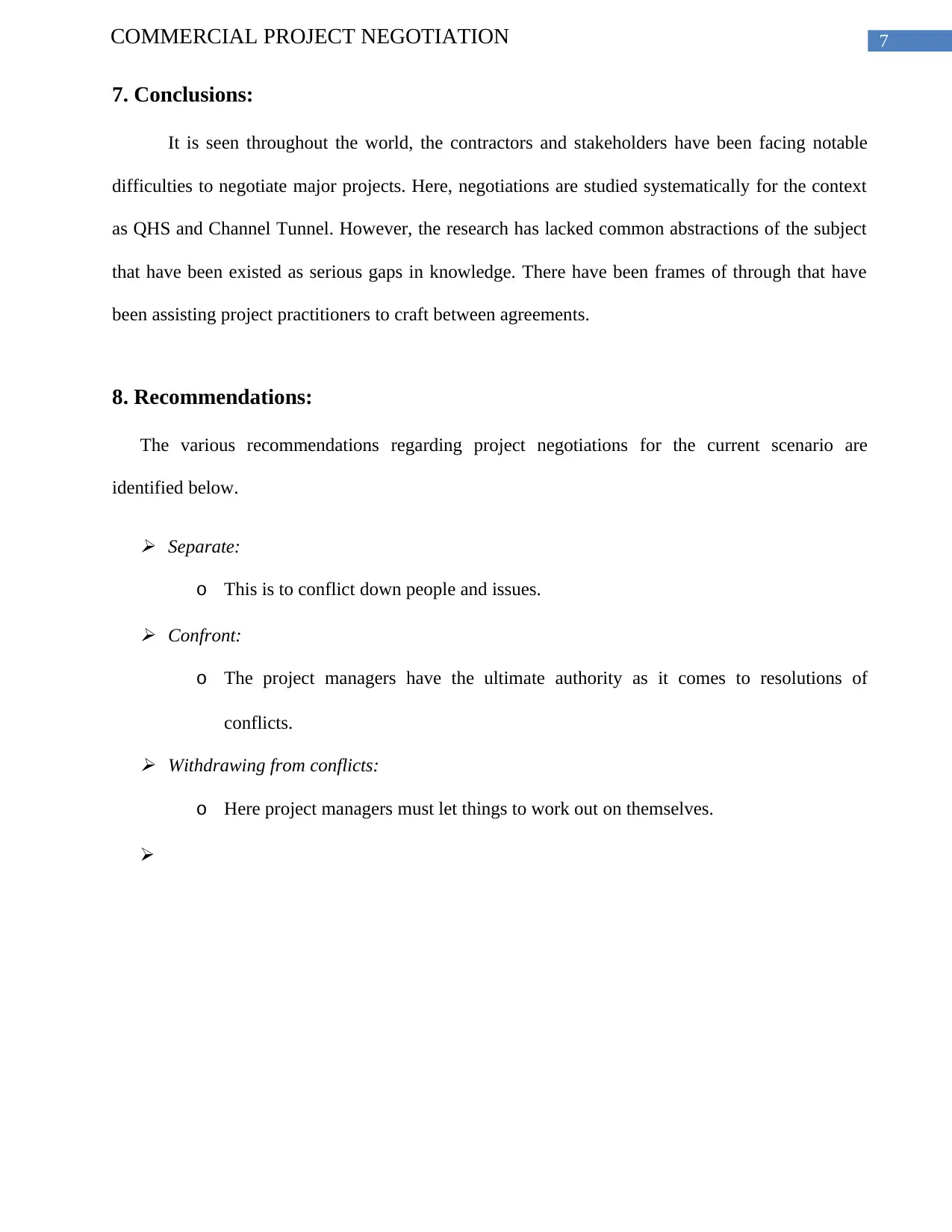
7COMMERCIAL PROJECT NEGOTIATION
7. Conclusions:
It is seen throughout the world, the contractors and stakeholders have been facing notable
difficulties to negotiate major projects. Here, negotiations are studied systematically for the context
as QHS and Channel Tunnel. However, the research has lacked common abstractions of the subject
that have been existed as serious gaps in knowledge. There have been frames of through that have
been assisting project practitioners to craft between agreements.
8. Recommendations:
The various recommendations regarding project negotiations for the current scenario are
identified below.
Separate:
o This is to conflict down people and issues. Confront:
o The project managers have the ultimate authority as it comes to resolutions of
conflicts. Withdrawing from conflicts:
o Here project managers must let things to work out on themselves.
7. Conclusions:
It is seen throughout the world, the contractors and stakeholders have been facing notable
difficulties to negotiate major projects. Here, negotiations are studied systematically for the context
as QHS and Channel Tunnel. However, the research has lacked common abstractions of the subject
that have been existed as serious gaps in knowledge. There have been frames of through that have
been assisting project practitioners to craft between agreements.
8. Recommendations:
The various recommendations regarding project negotiations for the current scenario are
identified below.
Separate:
o This is to conflict down people and issues. Confront:
o The project managers have the ultimate authority as it comes to resolutions of
conflicts. Withdrawing from conflicts:
o Here project managers must let things to work out on themselves.
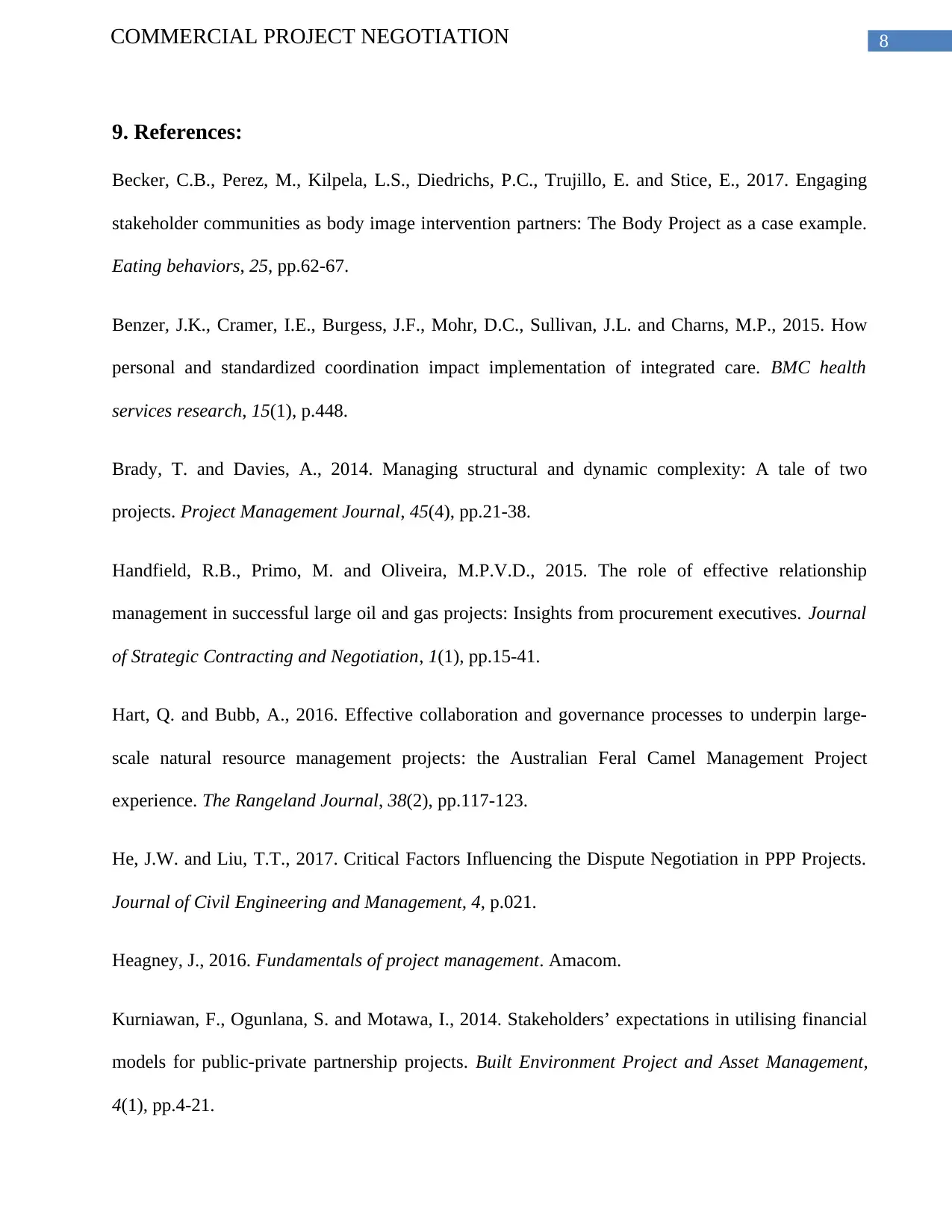
8COMMERCIAL PROJECT NEGOTIATION
9. References:
Becker, C.B., Perez, M., Kilpela, L.S., Diedrichs, P.C., Trujillo, E. and Stice, E., 2017. Engaging
stakeholder communities as body image intervention partners: The Body Project as a case example.
Eating behaviors, 25, pp.62-67.
Benzer, J.K., Cramer, I.E., Burgess, J.F., Mohr, D.C., Sullivan, J.L. and Charns, M.P., 2015. How
personal and standardized coordination impact implementation of integrated care. BMC health
services research, 15(1), p.448.
Brady, T. and Davies, A., 2014. Managing structural and dynamic complexity: A tale of two
projects. Project Management Journal, 45(4), pp.21-38.
Handfield, R.B., Primo, M. and Oliveira, M.P.V.D., 2015. The role of effective relationship
management in successful large oil and gas projects: Insights from procurement executives. Journal
of Strategic Contracting and Negotiation, 1(1), pp.15-41.
Hart, Q. and Bubb, A., 2016. Effective collaboration and governance processes to underpin large-
scale natural resource management projects: the Australian Feral Camel Management Project
experience. The Rangeland Journal, 38(2), pp.117-123.
He, J.W. and Liu, T.T., 2017. Critical Factors Influencing the Dispute Negotiation in PPP Projects.
Journal of Civil Engineering and Management, 4, p.021.
Heagney, J., 2016. Fundamentals of project management. Amacom.
Kurniawan, F., Ogunlana, S. and Motawa, I., 2014. Stakeholders’ expectations in utilising financial
models for public-private partnership projects. Built Environment Project and Asset Management,
4(1), pp.4-21.
9. References:
Becker, C.B., Perez, M., Kilpela, L.S., Diedrichs, P.C., Trujillo, E. and Stice, E., 2017. Engaging
stakeholder communities as body image intervention partners: The Body Project as a case example.
Eating behaviors, 25, pp.62-67.
Benzer, J.K., Cramer, I.E., Burgess, J.F., Mohr, D.C., Sullivan, J.L. and Charns, M.P., 2015. How
personal and standardized coordination impact implementation of integrated care. BMC health
services research, 15(1), p.448.
Brady, T. and Davies, A., 2014. Managing structural and dynamic complexity: A tale of two
projects. Project Management Journal, 45(4), pp.21-38.
Handfield, R.B., Primo, M. and Oliveira, M.P.V.D., 2015. The role of effective relationship
management in successful large oil and gas projects: Insights from procurement executives. Journal
of Strategic Contracting and Negotiation, 1(1), pp.15-41.
Hart, Q. and Bubb, A., 2016. Effective collaboration and governance processes to underpin large-
scale natural resource management projects: the Australian Feral Camel Management Project
experience. The Rangeland Journal, 38(2), pp.117-123.
He, J.W. and Liu, T.T., 2017. Critical Factors Influencing the Dispute Negotiation in PPP Projects.
Journal of Civil Engineering and Management, 4, p.021.
Heagney, J., 2016. Fundamentals of project management. Amacom.
Kurniawan, F., Ogunlana, S. and Motawa, I., 2014. Stakeholders’ expectations in utilising financial
models for public-private partnership projects. Built Environment Project and Asset Management,
4(1), pp.4-21.
⊘ This is a preview!⊘
Do you want full access?
Subscribe today to unlock all pages.

Trusted by 1+ million students worldwide
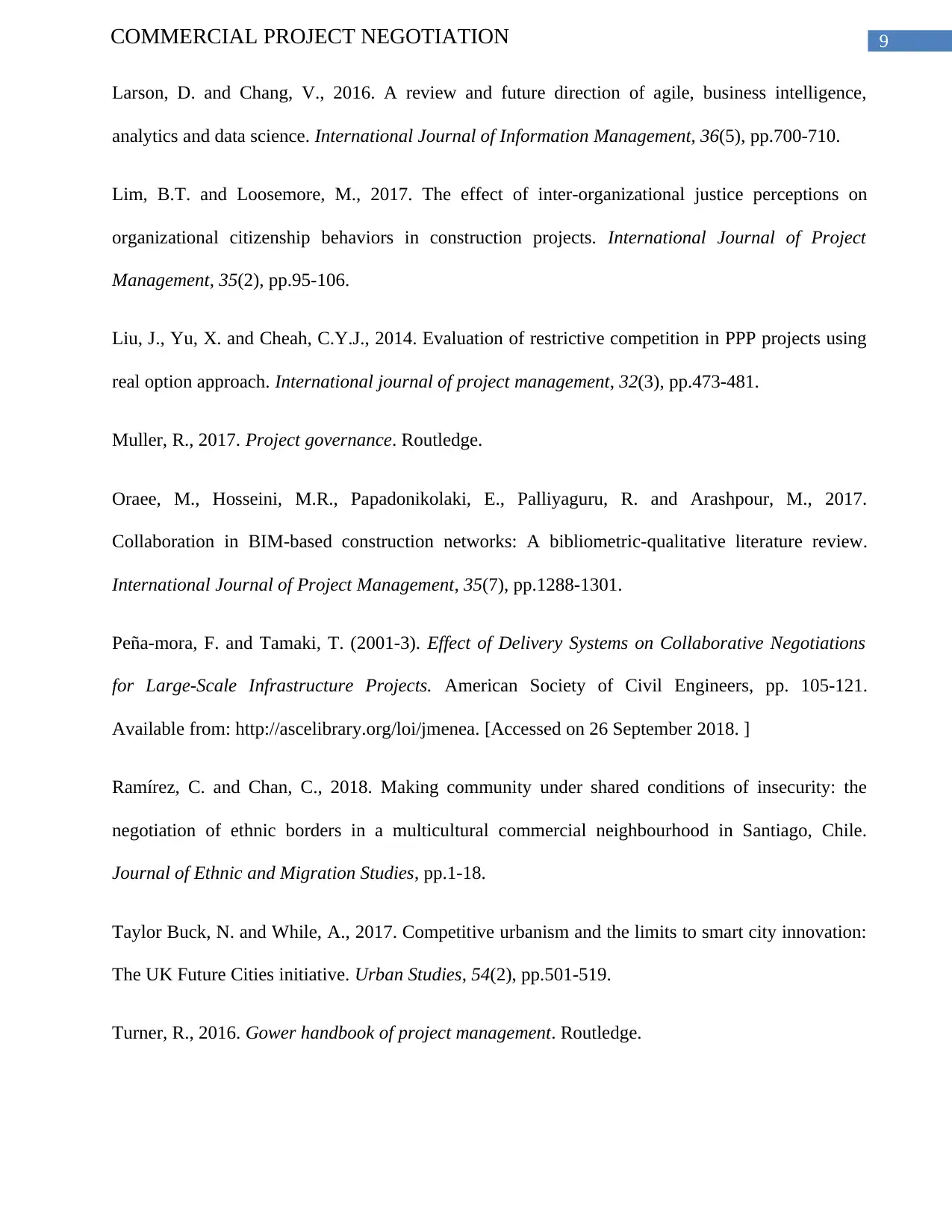
9COMMERCIAL PROJECT NEGOTIATION
Larson, D. and Chang, V., 2016. A review and future direction of agile, business intelligence,
analytics and data science. International Journal of Information Management, 36(5), pp.700-710.
Lim, B.T. and Loosemore, M., 2017. The effect of inter-organizational justice perceptions on
organizational citizenship behaviors in construction projects. International Journal of Project
Management, 35(2), pp.95-106.
Liu, J., Yu, X. and Cheah, C.Y.J., 2014. Evaluation of restrictive competition in PPP projects using
real option approach. International journal of project management, 32(3), pp.473-481.
Muller, R., 2017. Project governance. Routledge.
Oraee, M., Hosseini, M.R., Papadonikolaki, E., Palliyaguru, R. and Arashpour, M., 2017.
Collaboration in BIM-based construction networks: A bibliometric-qualitative literature review.
International Journal of Project Management, 35(7), pp.1288-1301.
Peña-mora, F. and Tamaki, T. (2001-3). Effect of Delivery Systems on Collaborative Negotiations
for Large-Scale Infrastructure Projects. American Society of Civil Engineers, pp. 105-121.
Available from: http://ascelibrary.org/loi/jmenea. [Accessed on 26 September 2018. ]
Ramírez, C. and Chan, C., 2018. Making community under shared conditions of insecurity: the
negotiation of ethnic borders in a multicultural commercial neighbourhood in Santiago, Chile.
Journal of Ethnic and Migration Studies, pp.1-18.
Taylor Buck, N. and While, A., 2017. Competitive urbanism and the limits to smart city innovation:
The UK Future Cities initiative. Urban Studies, 54(2), pp.501-519.
Turner, R., 2016. Gower handbook of project management. Routledge.
Larson, D. and Chang, V., 2016. A review and future direction of agile, business intelligence,
analytics and data science. International Journal of Information Management, 36(5), pp.700-710.
Lim, B.T. and Loosemore, M., 2017. The effect of inter-organizational justice perceptions on
organizational citizenship behaviors in construction projects. International Journal of Project
Management, 35(2), pp.95-106.
Liu, J., Yu, X. and Cheah, C.Y.J., 2014. Evaluation of restrictive competition in PPP projects using
real option approach. International journal of project management, 32(3), pp.473-481.
Muller, R., 2017. Project governance. Routledge.
Oraee, M., Hosseini, M.R., Papadonikolaki, E., Palliyaguru, R. and Arashpour, M., 2017.
Collaboration in BIM-based construction networks: A bibliometric-qualitative literature review.
International Journal of Project Management, 35(7), pp.1288-1301.
Peña-mora, F. and Tamaki, T. (2001-3). Effect of Delivery Systems on Collaborative Negotiations
for Large-Scale Infrastructure Projects. American Society of Civil Engineers, pp. 105-121.
Available from: http://ascelibrary.org/loi/jmenea. [Accessed on 26 September 2018. ]
Ramírez, C. and Chan, C., 2018. Making community under shared conditions of insecurity: the
negotiation of ethnic borders in a multicultural commercial neighbourhood in Santiago, Chile.
Journal of Ethnic and Migration Studies, pp.1-18.
Taylor Buck, N. and While, A., 2017. Competitive urbanism and the limits to smart city innovation:
The UK Future Cities initiative. Urban Studies, 54(2), pp.501-519.
Turner, R., 2016. Gower handbook of project management. Routledge.
Paraphrase This Document
Need a fresh take? Get an instant paraphrase of this document with our AI Paraphraser

10COMMERCIAL PROJECT NEGOTIATION
Van den Hurk, M., 2016. Bundling the procurement of sports infrastructure projects: How neither
public nor private actors really benefit. Environment and Planning C: Government and Policy,
34(8), pp.1369-1386.
Van Der Meer, J., Hartmann, A., Van Der Horst, A. and Dewulf, G., 2015. Challenges of using
systems engineering for design decisions in large infrastructure tenders. Engineering project
organization journal, 5(4), pp.133-145.
Wen, Q., Qiang, M. and An, N., 2017. Collaborating with construction management consultants in
project execution: Responsibility delegation and capability integration. Journal of Construction
Engineering and Management, 143(7), p.04017021.
Winch, G. and Leiringer, R., 2016. Owner project capabilities for infrastructure development: A
review and development of the “strong owner” concept. International Journal of Project
Management, 34(2), pp.271-281.
Van den Hurk, M., 2016. Bundling the procurement of sports infrastructure projects: How neither
public nor private actors really benefit. Environment and Planning C: Government and Policy,
34(8), pp.1369-1386.
Van Der Meer, J., Hartmann, A., Van Der Horst, A. and Dewulf, G., 2015. Challenges of using
systems engineering for design decisions in large infrastructure tenders. Engineering project
organization journal, 5(4), pp.133-145.
Wen, Q., Qiang, M. and An, N., 2017. Collaborating with construction management consultants in
project execution: Responsibility delegation and capability integration. Journal of Construction
Engineering and Management, 143(7), p.04017021.
Winch, G. and Leiringer, R., 2016. Owner project capabilities for infrastructure development: A
review and development of the “strong owner” concept. International Journal of Project
Management, 34(2), pp.271-281.
1 out of 11
Related Documents
Your All-in-One AI-Powered Toolkit for Academic Success.
+13062052269
info@desklib.com
Available 24*7 on WhatsApp / Email
![[object Object]](/_next/static/media/star-bottom.7253800d.svg)
Unlock your academic potential
Copyright © 2020–2025 A2Z Services. All Rights Reserved. Developed and managed by ZUCOL.



